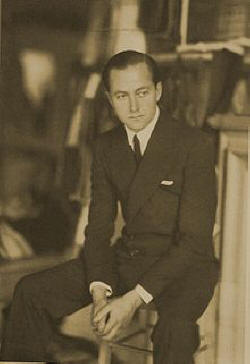

Queer Places:
Beaumont College, Burfield Rd, Old Windsor SL4 2JJ, UK
5 Rue Royale, 75008 Paris, France
 Edward
Henry Molyneux (pronounced "Molinucks";[1]
5 September 1891 in Hampstead, London – 23 March 1974 in Monte Carlo) was a
leading British fashion designer whose salon in Paris was in operation from
1919 until 1950. Molyneux, of Irish and French Huguenot ancestry, had a complicated personal
life. One of his early relationships was with Foreign Office diplomat
Harold Nicolson,
who helped finance the opening of the designer's first Paris salon. Although
married to writer
Vita
Sackville-West, Nicolson was open with her about his affairs, including
his fling with Molyneux.[7]
Edward
Henry Molyneux (pronounced "Molinucks";[1]
5 September 1891 in Hampstead, London – 23 March 1974 in Monte Carlo) was a
leading British fashion designer whose salon in Paris was in operation from
1919 until 1950. Molyneux, of Irish and French Huguenot ancestry, had a complicated personal
life. One of his early relationships was with Foreign Office diplomat
Harold Nicolson,
who helped finance the opening of the designer's first Paris salon. Although
married to writer
Vita
Sackville-West, Nicolson was open with her about his affairs, including
his fling with Molyneux.[7]
Born in London to Justin Molyneux and Lizzy Kenny, Edward Molyneux attended Beaumont College, a Roman Catholic preparatory school. Owing to the death of his father, he dropped out at age 16 to support himself and his mother while pursuing ambitions as a painter and illustrator. Molyneux soon found employment as a sketch artist for the London magazine Smart Set where his drawings of fashionable women attracted the attention of the celebrated couturier Lucile (in private life Lady Duff Gordon). She hired him as a sketcher in her London salon in 1910 and by the end of the following year had promoted him to assistant designer at her Paris branch.[2]
Working for Lucile in London, Paris and New York until the outbreak of World War I, Molyneux joined the British Army's Duke of Wellington regiment with which he fought in the Battle of Arras, attaining the rank of captain but losing the sight in one eye. He returned to work for Lucile after being invalided out of the war but a disagreement with her resulted in his termination in 1919.[3]
Molyneux opened his own fashion house in Paris at 14 rue Royale in November 1919 (later, 5 rue Royale), expanding to Monte Carlo in 1925, Cannes in 1927, and London in 1932. The designer quickly became known for an impeccably refined simplicity. Molyneux was, as historian Caroline Milbank wrote, "the designer to whom a fashionable woman would turn if she wanted to be absolutely right without being utterly predictable in the Twenties and Thirties."[4] Frowning on superfluous decoration, he regularly dressed European royals, including Princess Marina, Duchess of Kent.[5] He was also a favorite with trendsetting actresses like Greta Garbo, Marlene Dietrich, Gertrude Lawrence, Margaret Leighton, and Vivien Leigh. Proteges included future couturiers Christian Dior and Pierre Balmain, and he was friends with playwright Noël Coward.
During World War II, he moved his firm to London for the duration of the conflict and returned to Paris in 1946. Retiring in 1950, Molyneux left his fashion house in the hands of Jacques Griffe. He resumed designing in 1964, opening Studio Molyneux, a high quality ready-to-wear line that received mixed reviews. During this period Time magazine described him as "the Parisian equivalent of Manhattan's Mainbocher, a classicist devoted to the soft look and tailored line."[6] He retired again in 1969, but Studio Molyneux continued under the direction of his cousin John Tullis until it closed in 1977.
The Molyneux trademark is owned by French company Parfums Berdoues, and though the fashion component of the firm remains dormant, the firm still produces scents, such as Captain (1975), Quartz (1978), Le Chic, Vivre, I Love You and Quartz Pure Red (2008).
Iin 1923 Molyneux married (Jessie) Muriel Dunsmuir (1890–1951), one of eight daughters of the Hon. James Dunsmuir, Premier of British Columbia, and sister of Dola Dunsmuir Cavendish. They divorced in 1924.
My published books: